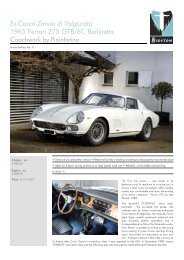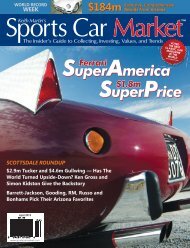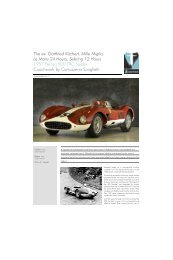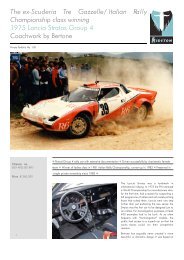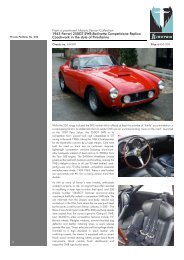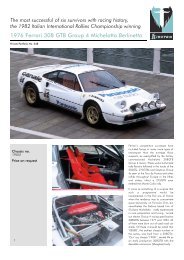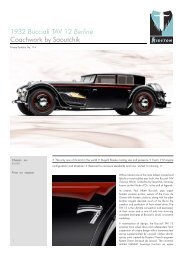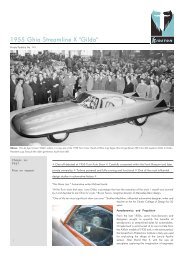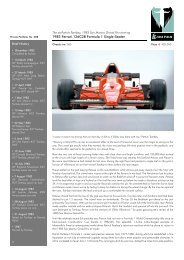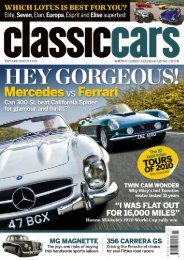Create successful ePaper yourself
Turn your PDF publications into a flip-book with our unique Google optimized e-Paper software.
75 pages ‣ ‣<br />
Exclusive coverage of Monterey's record $198m sales<br />
Sports<br />
Keith Martin’s<br />
Car Market<br />
The Insider’s Guide to Collecting, Investing, Values, and Trends<br />
$16.4m<br />
What else is there to say?<br />
<strong>2011</strong><br />
VOTED<br />
THE BEST<br />
CLASSIC CAR<br />
MAGAZINE<br />
IN THE<br />
WORLD<br />
www.about.com<br />
<strong>November</strong> <strong>2011</strong><br />
www.sportscarmarket.com<br />
McQueen's 911S: The $1.4m "cool factor"<br />
Mercedes 540K brings record $9.7m
Ferrari Profile<br />
1957 Ferrari 250 Testa Rossa Prototype<br />
Chassis number 0666 is appropriate for a car that has been to hell —<br />
and back to set an auction record<br />
by Simon <strong>Kidston</strong><br />
Pawel Litwinski, courtesy of Gooding & Company<br />
Details<br />
Years produced: 1957–1958 (250 Testa<br />
Rossa)<br />
Number produced: 21 (pontoon fenders)<br />
Original list price: $12,000<br />
Current SCM valuation: $10m–$24m<br />
(all 12-cylinder Testa Rossa models)<br />
Tune-up cost: $2,500<br />
Distributor caps: $450 each (takes two)<br />
Chassis # location: Left frame member<br />
by steering box<br />
Engine number location: Right rear above<br />
motor mount<br />
Club: Ferrari Club of America<br />
More: www.ferrariclubofamerica.org<br />
Alternatives:<br />
1955–1956 Maserati 300S<br />
1956–1959 Aston Martin DBR1<br />
1955–1957 Jaguar D-type<br />
SCM Investment Grade: A<br />
Comps<br />
Chassis number: 0666 TR<br />
The development of the Ferrari 250 TR began in<br />
early 1957 with the car presented here, 0666 TR,<br />
which has the distinction of serving as the first<br />
prototype for the 250 Testa Rossa series.<br />
0666 TR made its debut at the Nürburgring 1,000<br />
Km, coming 6th in qualifying and 10th in the race.<br />
It then underwent development and appeared at the<br />
Swedish Grand Prix equipped with an experimental 3.1-<br />
liter engine, but this gave out, and the car retired.<br />
Between September and October 1957, 0666 TR<br />
was stripped of its envelope body and refinished by<br />
Scaglietti in the quintessential pontoon-fender style. At<br />
that time, the prototype received its definitive driveline,<br />
complete with the Tipo 128 LM Testa Rossa motor and<br />
4-speed gearbox.<br />
This car then participated in the Venezuelan Grand<br />
Prix, coming in 3rd overall, before being transported<br />
to Argentina for the first race of the 1958 season, the<br />
Buenos Aires 1000 Km, finishing 2nd overall. The Targa<br />
Florio was the last outing for 0666 TR as a Scuderia<br />
Ferrari team car. It was in 4th place when it retired.<br />
In June 1958, 0666 TR was sold to Luigi Chinetti and<br />
delivered to him at Le Mans to be driven by Dan Gurney<br />
and Bruce Kessler. At around 10 pm in the rain, Kessler<br />
collided with a privately entered D-type Jaguar, resulting<br />
in a fire and the Testa Rossa’s subsequent retirement.<br />
The incident required a factory rebuild and a fresh<br />
pontoon-fender body from Scaglietti. By the beginning<br />
of 1959, Chinetti realized that 0666 TR would<br />
not be competitive, and it was sold to Rod Carveth, a<br />
Californian privateer who entered it for the 12 Hours of<br />
Sebring, where it retired. The same fate awaited Carveth<br />
and 0666 TR at the Nürburgring 1000 Km. In June the<br />
Ferrari traveled to Le Mans, where the engine failed on<br />
the Mulsanne straight. At Laguna Seca, Phil Hill drove<br />
0666 TR but it didn’t qualify.<br />
In June 1962, Carveth offered the car for sale. Enter<br />
0666 TR’s fourth owner, Bev Spencer, a local Buick<br />
dealer who used it as his personal street car until his<br />
new 250 GTO arrived.<br />
After the original engine finally gave out, it was removed<br />
and traded to Pete Lovely. When its then-owner<br />
believed the aging Ferrari was worth more in cash than<br />
as a car, he doused the interior in gasoline and set it on<br />
fire. While it was enough to collect the insurance money,<br />
the result was little more than a superficial burn. In<br />
1970, Charles Betz and Fred Peters purchased the Testa<br />
Rossa. Over the next decade, 0666 TR was restored to a<br />
show-quality standard using an appropriate engine from<br />
0724 TR.<br />
By the late 1980s, the restoration was complete,<br />
and 0666 TR began collecting concours awards. In<br />
2002, Betz and Peters sold it to the current caretaker,<br />
a preeminent collector, who commissioned Dennison<br />
International to complete a restoration that would bring<br />
0666 TR back to its original team-car appearance and<br />
specification. Instrumental to this project was a significant<br />
acquisition: the original, matching-numbers engine<br />
1958 Ferrari 250 Testa Rossa Pontoon<br />
Fender<br />
Lot 357, s/n 0738TR<br />
Condition: 2<br />
Not Sold at $10.7m<br />
RM Auctions, Monterey, CA, 8/13/10<br />
SCM# 165590<br />
1957 Ferrari 250 Testa Rossa Pontoon<br />
Fender<br />
Lot 237, s/n 0714TR<br />
Condition: 1<br />
Sold at $12,402,500<br />
RM Auctions, Maranello, 5/17/2009<br />
SCM# 120485<br />
1962 Ferrari 330 TRI/LM Testa Rossa<br />
Lot 221, s/n 0808<br />
Condition: 2<br />
Sold at $9,281,250<br />
RM Auctions, Maranello, Italy, 5/20/07<br />
SCM# 45296<br />
36 Sports Car Market
SCM<br />
Digital Bonus<br />
and a correct rear differential.<br />
The freshly restored prototype 250 TR made its<br />
debut at the 2006 Pebble Beach Concours d’Elegance<br />
and earned a First in Class. At the Cavallino Classic,<br />
it took an FCA Platinum Award and the TR Cup. At<br />
the 2007 Ferrari Club of America Meet, it received the<br />
Coppa Bella Macchina, the Coppa GT and its second<br />
Phil Hill Award.<br />
With its prototype status, exquisite beauty, proud<br />
race record and uncommon authenticity, 0666 TR<br />
must be considered one of the great Ferrari sports racing<br />
cars.<br />
This Ferrari 250 Testa Rossa, Lot<br />
SCM Analysis<br />
18, sold for $16,390,000, including<br />
buyer’s premium, at Gooding’s Pebble Beach sale<br />
on August 20, <strong>2011</strong>. This price sets a new world record<br />
for the highest amount ever paid for a motor car at<br />
auction.<br />
There’s far more to say about this unique motor car than we can fit into these<br />
pages, so I’ll get straight to the point. The 250 Testa Rossa is Ferrari’s most celebrated<br />
sports-racing model, a legend in car collecting circles and one of the most valuable<br />
cars in the world. Introduced in 1957 in anticipation of the upcoming 3-liter limit in<br />
the World Sports Car Championship, it stole a march on rivals Jaguar and Maserati,<br />
who had been pinning their hopes on “big bangers” such as the D-type and 450S,<br />
and achieved success everywhere it raced, from Europe and South America to the allimportant<br />
SCCA races contested by Ferrari’s wealthy U.S. privateer clients, earning<br />
the company healthy profits.<br />
Named Testa Rossa (pronounced “ross-ah,” not “rose-ah,” meaning “redhead”)<br />
after its red cam covers, 34 of these cars were built from 1957 until 1962. No two were<br />
identical, but Works TRs were generally right-hand drive.<br />
From 1959 onward, production was devoted to Works cars, which featured disc<br />
brakes and separate gearboxes with rear differentials. All except the last TR (0808)<br />
had 3-liter motors largely derived from the production 250 GT.<br />
Dueling opinions on pre-sale value<br />
Our subject car, 0666 TR, is the first of two prototypes, both of which ran as works<br />
cars. As with all prototypes, there will be buyers who prefer the recognition of the<br />
standard model and others who enjoy owning something different. I exchanged opinions<br />
with many experts and fellow TR owners before and after the auction as to the<br />
value of this car and its historical significance — and heard both ends of the spectrum.<br />
“A friend of mine would pay eight to ten million,” said one owner, “as it’s not a<br />
standard TR chassis, and I doubt much of the original bodywork survives.” This, of<br />
course, was a reference to not one but two fires that the car endured during its early<br />
years.<br />
Other TR owners were more upbeat, confiding that they had received approaches<br />
north of $20m for their cars and that the auction estimate seemed reasonable for 0666.<br />
It would be British understatement to say that on the evening of August 20, in the<br />
middle of a worldwide economic storm, there was widespread interest in the fate that<br />
awaited this very high-profile Ferrari under the auctioneer’s gavel.<br />
They needn’t have worried. A new collector — just starting out at 73 years old —<br />
kicked off proceedings with a $10m bid. Rapid salvos ensued: $11m, $11.5m, $11.8m.<br />
At $12.4m, the auctioneer announced the reserve had been met, and it became a<br />
two-horse race between an absentee bidder and a telephone bidder in mostly $100k<br />
increments. When the mystery phone bidder prevailed at $14.9m, the hammer went<br />
down and cheers went up.<br />
A rich, sometimes painful, life<br />
To paint an accurate picture of this car, I consulted<br />
various sources. David Gooding opined that the 250 TR<br />
is undervalued compared with its closed sister, the 250<br />
GTO — a sentiment echoed by many (most vocally those<br />
TR owners who don’t also have a GTO) — and that given<br />
time, this will seem a good buy. Gooding believed that<br />
0666’s history was more illustrious than most, and when<br />
shown the post-fire photographs, bidders had remarked<br />
the damage wasn’t as bad as expected.<br />
To get to the bottom of the controversy about the fires,<br />
I went to Maranello and met with our friends at Ferrari<br />
Classiche. “Chassis 0666? Of course we remember it.<br />
We called it ‘La Bastarda!’”<br />
Was the chassis replaced after the Le Mans accident?<br />
“Definitely not. Only the upper part of the car was damaged.<br />
Look, it’s all here on the microfilm, everything….”<br />
Lastly, I consulted a well-known Ferrari historian.<br />
How many 250 TRs does he think have their original<br />
bodywork? “Perhaps 60% but it’s hard to say, as for<br />
years nobody bothered to track such information.” Let’s<br />
face it, these bodies were cigarette-paper thin and intended<br />
to last a few race seasons — not decades.<br />
And what, in his opinion, would the very best 250 TR<br />
be worth? “That would be one of the Le Mans winners.<br />
They almost never come up, so I’d have to say $25 million.”<br />
A car for the ages<br />
Did the new owner of 0666 TR get caught up in the<br />
Monterey euphoria and overpay, or was this a shrewd<br />
investment?<br />
On the one hand, we have a unique factory prototype<br />
with a front-line international racing history. The majority<br />
of 250 TRs were customer cars destined for weekend<br />
outings around airfields serving as SCCA circuits.<br />
This one roared around Le Mans, the Targa Florio and<br />
the ’Ring — piloted by all-time heroes.<br />
Conversely, it led a hard life as a race car and later<br />
as an old hack. The chassis number 0666 is prophetic,<br />
as it’s been to hell and back. Ultimately, though, it’s<br />
been cherished for the past 40 years, restored without<br />
regard to expense, and the Ferrari factory has given it<br />
their unquestioned blessing.<br />
Auctions are a roll of the dice that not all sellers want<br />
to risk, but in this case the gamble paid off. Well sold<br />
today, well bought for posterity. ♦<br />
(Introductory description courtesy of Gooding &<br />
Company.)<br />
SCM Digital Bonus. Additional images, and more...<br />
<strong>November</strong> <strong>2011</strong> 37



